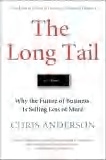Here’s another long post, but I suspect you’ll find it worth the ride. It will paint a picture of what mobile marketing will be like, much sooner than you may think. Actually, it will paint a picture of what person-to-person retail (as opposed to digital retail) will be like, because mobile devices will merely be the means that will take us to this fascinating future.
If you’re a new reader, I need to explain why I write this thing. I strive not to be part of the echo chamber that is current public discourse. By echo chamber, I mean the repetition of the same hot concept or idea until it starts to sound credible. Many occupational blogs (as opposed to recreational blogs), merely convey the industry “news” of the day. Sometimes that’s worthwhile. But other times, the repetition contributes to a pattern of half-baked ideas taking on more significance than they deserve.
My hope is to make sense of what’s happening or about to happen in marketing technology — and occasionally to pass along a juicy tip or two that you can use right now. Rishad Tobaccowala, chief innovation officer of Publicis, put it well. He’s with one of the world’s biggest advertising groups. Tobaccowala was quoted in The Economist as saying, “All of us have been classically trained, and now we’re in a jazz age.”
We’re all riffing, my friend, and I’m hoping this blog will help keep the improvisation going.
Let me steer us back from that digression. I mentioned The Economist, which you must understand is not just a magazine about economics. Although, to use a famous Seinfeld quote, “Not that there’s anything wrong with that.” On the contrary. Living, breathing economics is much like living, breathing history. By that I mean the following:
- Economics bears no resemblance to what most of us were exposed to in school
- Economics is extremely helpful in making sense of this furiously changing world
A case in point is the mundane and exciting observations of economist Tim Harford. In his recent book, The Undercover Economist, he sets us straight about Starbucks. We think they are larger and more powerful than they are because they have a location on every corner of major cities — or so it seems. He uses the example of how you cannot pass into or out of Washington D.C.’s Metro Station without encountering at least one Starbucks.
Yet that is proof not of the seductive draw of their products, but of the weak gravitational pull that they exert. By contrast, Mr. Harford points out that there is only one Washington D.C. Department of Motor Vehicles. If you have a problem with your driver’s license, you must go there and suffer. And people do. They must.
That’s power. That’s scarcity! Conversely, Starbucks knows that the majority of coffee drinkers are quite fickle about where they buy their coffee. It just so happens that Starbucks is big enough to buy up those scarce good locations so that they consistently arrive in our faces when we round the next corner.
The scarcity is not in the lattes and cappuccinos, but in the prime locations from which they are proffered. This is why, he asserts, Starbucks is not nearly as wealthy, in relative terms, as the merchants of those selling opportunities — namely, the landlords who rent to Starbucks and the property owners and brokers who sell to Starbucks. A validation of this theory can be found in a recent New York Times article about the proliferation of bank branches and the property boomlet that this industry expansion has ignited.
Banks, too, know that they are selling a near-commodity. And so it goes: the tyranny of location, location, location.
Imagine if these industry leaders could say, “To hell with these physical locations. We’re stuck in place while our customers travel around the city. That’s just dumb!” Or more likely, what if this declaration was from non-leaders in their industries? After all, the leaders in gourmet coffees and financial services have much invested in their physical brand. It stands to reason that it is the upstart competitors who will stage the more nimble attacks, just as small bands of guerrilla-fighting American Revolution soldiers sprung out of the bushes to fight and ultimately defeat the legions of lockstep Redcoats.
But how will this assault be staged? I’m suggesting that there will someday be a mobile army of coffee merchants and bank branches. These establishments on wheels will find their customers around the next corner because they will see them coming from ever-changing maps of movements and probabilities.
Why maintain a brand address, after all, when you’ve trained your customers to expect you to show up exactly where and when they need you? Of course, this data will come from the only possession other than our wallets that we dare not leave home without (and soon enough those two will merge into one!). I’m speaking of course of the cell phone.
Already, privacy-protected surveillance is being done on a city-wide scale. You can read of several such studies on the following MIT web site, but I’m going to quote from one such study, about a “realtime” Rome, Italy:
In the visualizations of Real Time Rome we synthesize data from various real-time networks to understand patterns of daily life in Rome. We interpolate the aggregate mobility of people according to their mobile phone usage and visualize it synchronously with the flux of public transit, pedestrians, and vehicular traffic.
By overlaying mobility information on geographic and socio-economic references of Rome we unveil the relationships between fixed and fluid urban elements. These real-time maps help us understand how neighborhoods are used in the course of a day, how the distribution of buses and taxis correlates with densities of people, how goods and services are distributed in the city, or how different social groups, such as tourists and residents, inhabit the city. With the resulting visualizations users can interpret and react to the shifting urban environment.
How cool is that?
When I first saw these maps, which surge and pulse with life, I thought they were interesting but were like many technologies — a solution in search of a problem. Now I think I’ve found the problem: Taking power from the owners and renters of real estate and putting them in the hands of retailers. And in doing so, making life for their customers easier and more pleasant.
I’d love to go on and address the objections that I’m sure you have about privacy, and the ability to move branch locations through congested urban streets. Those answers will have to wait (unless you’d care to ask me in the Comments area — in which case I’ll be much obliged). But for now, I’ll leave you with this thought:
If a retailer …
- Analyzed aggregate cell phone data about your movements as well as everyone else’s who want the same services as you, and …
- Anticipated through statistical means where to locate itself to fulfill those needs, and …
- Alerted you through that same cell phone where they are in real time (e.g., “We’re two blocks away — care for your favorite beverage?”) …
Would you choose instead to go out of your way, back to those place-bound merchants you visit now?
I suspect that this consumer choice is quickly on its way.
 hoopla on Chris Anderson’s long-awaited book, aptly titledÂ
hoopla on Chris Anderson’s long-awaited book, aptly titled 